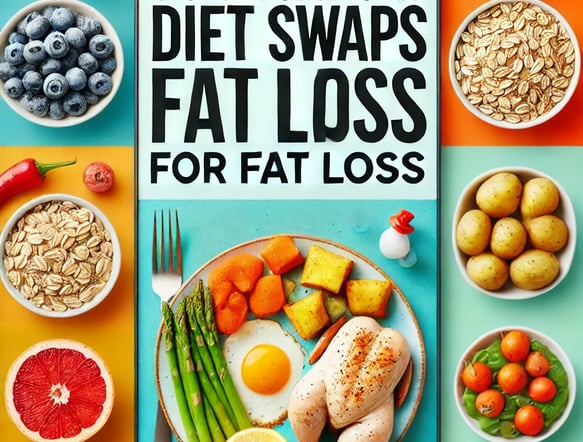Unlock Faster Fat Loss with These 3 Simple Diet Swaps
DIET
1/23/20253 min read


Losing weight is often associated with the simple rule of "calories in versus calories out." While this principle holds true, it overlooks how the types of foods we eat influence how our bodies process those calories. The truth is, making small, strategic changes to your diet can help you burn fat more efficiently and stick to your weight loss goals with ease.
In this blog post, we’ll explore three game-changing dietary swaps that can accelerate your fat loss journey. Plus, we’ll provide a sample meal plan to show you how to incorporate these tips into your daily routine. Let’s dive in!
Why Calories Alone Aren’t Enough
Calories are the cornerstone of weight loss. If you’re in a calorie deficit—consuming fewer calories than you burn—you’ll lose weight. However, what this model doesn’t address is how different foods affect your metabolism, appetite, and energy levels.
Research has shown that the types of foods you eat can influence the thermic effect of food (TEF), or the energy your body uses to digest and metabolize nutrients. By choosing foods with a higher TEF and better satiety properties, you can optimize your fat loss without feeling deprived or hungry.
Let’s look at three effective swaps to make this happen.
Swap 1: Choose Minimally Processed Foods
Processed foods might be convenient, but they can undermine your fat loss efforts. Opt for minimally processed, nutrient-dense options like oats, brown rice, and whole grain bread instead of their refined counterparts, such as cereal, white rice, and white bread.
The Science Behind It
A study comparing whole grain sandwiches to processed sandwiches found that the whole grain option resulted in a 50% higher thermic effect. Another six-week trial revealed that participants who ate whole grain foods burned an additional 100 calories per day—the equivalent of jogging a mile—simply by switching to less processed foods.
Actionable Tips
Replace sugary breakfast cereals with oatmeal topped with fresh fruits and nuts.
Use whole grain bread for sandwiches instead of white bread.
Choose brown rice or quinoa over white rice in your meals.
Swap 2: Front-Load Your Calories
When it comes to distributing your daily calorie intake, timing matters. Research suggests that consuming a higher proportion of your calories earlier in the day, particularly at breakfast, can help control hunger, boost energy levels, and even enhance fat loss.
Benefits of a Front-Heavy Diet
Reduced Cravings: A 2020 study found that participants who ate a calorie-dense breakfast experienced fewer sweet cravings throughout the day.
Higher Energy Levels: A balanced breakfast helps sustain energy and encourages movement, burning more calories throughout the day.
Improved Fat Loss: Long-term studies indicate that front-loading calories can result in greater weight loss and waist circumference reduction compared to eating more calories at dinner.
Actionable Tips
If you’re intermittent fasting, consider breaking your fast with a calorie-dense, protein-packed meal.
Shift some calories from your dinner to breakfast or lunch.
Experiment with meals like protein pancakes or avocado toast with eggs for breakfast.
Swap 3: Focus on Satiating Foods
Eating foods that keep you full for longer is crucial to sticking to your calorie deficit. The Satiety Index, which ranks foods based on their ability to satisfy hunger, highlights how some options—like boiled potatoes and oats—are far more satiating than others, such as white bread or rice.
Top Satiating Foods to Include
Boiled Potatoes: Ranked highest on the Satiety Index, they can help you feel full without overloading on calories.
Oats: A versatile, filling option for breakfast or snacks.
Lean Protein: Foods like chicken, salmon, and Greek yogurt are excellent for satiety and muscle maintenance.
High-Fiber Vegetables: Broccoli, spinach, and asparagus are low in calories and high in volume.
Actionable Tips
Swap white rice for boiled potatoes or quinoa.
Use oats as a base for breakfast or snacks instead of refined grains.
Incorporate more lean proteins and fiber-rich vegetables into your meals.
Sample Meal Plan for Faster Fat Loss
Here’s a 2,100-calorie meal plan incorporating these swaps. Adjust portion sizes to fit your calorie needs:
Breakfast: Protein Pancakes
Blend oats into flour and mix with egg whites, cinnamon, and a splash of almond milk. Cook on a pan and top with peanut butter and fresh berries.
Lunch: Salmon and Boiled Potatoes
Serve baked salmon with boiled potatoes and a side of sautéed asparagus.
Snack: Orange and Protein Shake
Have an orange and a protein shake to keep you energized until dinner.
Dinner: Chicken Breast and Veggies
Roast chicken breast with olive oil, broccoli, and bell peppers.
Dessert: Greek Yogurt Parfait
Mix plain Greek yogurt with stevia and cinnamon, and top with frozen berries and chia seeds.
Conclusion: Optimize Your Diet for Results
While maintaining a calorie deficit is the foundation of weight loss, fine-tuning your diet with these strategic swaps can help you lose fat faster, control cravings, and improve your overall energy levels. Start by prioritizing whole, minimally processed foods, front-loading your calories, and incorporating highly satiating ingredients into your meals.
If you’re ready to take your fat loss journey to the next level, experiment with these swaps and see what works best for your lifestyle. For more science-backed tips, meal plans, and workout advice, subscribe to our newsletter and follow us on social media. Share this post with a friend who could benefit from these simple yet effective fat loss strategies!

